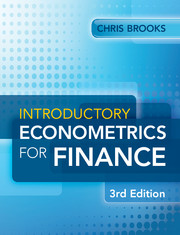Book contents
- Frontmatter
- Contents
- List of figures
- List of tables
- List of boxes
- List of screenshots
- Preface to the third edition
- Acknowledgements
- 1 Introduction
- 2 Mathematical and statistical foundations
- 3 A brief overview of the classical linear regression model
- 4 Further development and analysis of the classical linear regression model
- 5 Classical linear regression model assumptions and diagnostic tests
- 6 Univariate time series modelling and forecasting
- 7 Multivariate models
- 8 Modelling long-run relationships in finance
- 9 Modelling volatility and correlation
- 10 Switching models
- 11 Panel data
- 12 Limited dependent variable models
- 13 Simulation methods
- 14 Conducting empirical research or doing a project or dissertation in finance
- Appendix 1 Sources of data used in this book
- Appendix 2 Tables of statistical distributions
- Glossary
- References
- Index
2 - Mathematical and statistical foundations
- Frontmatter
- Contents
- List of figures
- List of tables
- List of boxes
- List of screenshots
- Preface to the third edition
- Acknowledgements
- 1 Introduction
- 2 Mathematical and statistical foundations
- 3 A brief overview of the classical linear regression model
- 4 Further development and analysis of the classical linear regression model
- 5 Classical linear regression model assumptions and diagnostic tests
- 6 Univariate time series modelling and forecasting
- 7 Multivariate models
- 8 Modelling long-run relationships in finance
- 9 Modelling volatility and correlation
- 10 Switching models
- 11 Panel data
- 12 Limited dependent variable models
- 13 Simulation methods
- 14 Conducting empirical research or doing a project or dissertation in finance
- Appendix 1 Sources of data used in this book
- Appendix 2 Tables of statistical distributions
- Glossary
- References
- Index
Summary
Learning outcomes
In this chapter, you will learn how to
• Work with powers, exponents and logarithms
• Use sigma (Σ) and pi (Π) notation
• Apply simple rules to differentiate functions
• Work with matrices
• Calculate the trace, inverse and eigenvalues of a matrix
• Construct minimum variance and mean-variance efficient portfolios
• Compute summary statistics for a data series
• Manipulate expressions using the expectations, variance and covariance operators
This chapter covers the mathematical and statistical building blocks that are essential for a good understanding of the rest of the book. Those with some prior background in algebra and introductory statistics may skip this chapter without loss of continuity, but hopefully the material will also constitute a useful refresher for those who have studied mathematics but a long time ago!
Functions
2.1.1 Straight lines
The ultimate objective of econometrics is usually to build a model, which may be thought of as a simplified version of the true relationship between two or more variables that can be described by a function. A function is simply a mapping or relationship between an input or set of inputs, and an output. We usually write that y, the output, is a function f of x, the input: y = f(x).
Information
- Type
- Chapter
- Information
- Introductory Econometrics for Finance , pp. 28 - 74Publisher: Cambridge University PressPrint publication year: 2014
